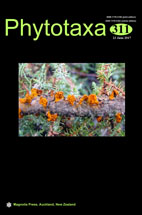Abstract
Based on molecular evidence and morphological analyses, a new species in the genus Trametopsis is revealed. Trametopsis aborigena sp. nov. is proposed and described from South America. Molecular phylogenetic analyses of ITS and LSU rDNA sequences suggest that Trametopsis cervina seems to encompass more than one species and confirm previous results showing that Antrodiella brasiliensis groups with Trametopsis. The morphological analyses of type specimens of A. brasiliensis and A. luteocontexta revealed a shared morphological pattern with Trametopsis and their combinations in Trametopsis are proposed. The circumscription of Trametopsis is discussed since all the studied specimens revealed a previously overlooked arrangement of characters, i.e., cylindrical and slightly curved to allantoid basidiospores and a metachromatic hyphal system monomitic in the context and dimitic in the tubes.

